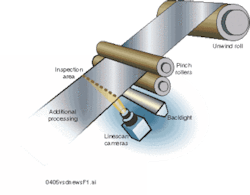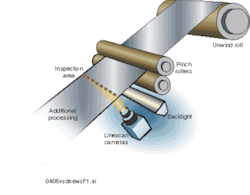Linescan measurement system targets web inspection
Developers of web-inspection systems often use high-speed linescan cameras coupled to PC-based frame grabbers. In such systems, linescan data are captured by the linescan camera, often processed on-the-fly by the PC, and the result is used to control marking or motor-control systems that may mark specific sections of the web or control the motion of the web material. Depending on each application, designers must make trade-offs between the type of cameras, frame grabbers, and host controllers they choose.
"Many machine-vision applications do not require gray-scale images to be captured and analyzed," says John Theys, director of research-and-development at Diversified Optronix (Milford, CT, USA; www.divop.com). "In steel-web inspection, measuring the width of steel or the position of defects on the roll does not require sophisticated image-processing algorithms." However, in such applications, captured data must be analyzed very quickly and be used to control mechanical feedback mechanisms on the web at high speed. An off-the-shelf linescan camera and frame grabber coupled to an industrial PC can be used. The PC can process the information from the camera and control external devices. While such methods are effective, the systems integrator is still required to implement software to perform measurement applications and trigger output devices.
Recognizing this, a number of manufacturers, including Diversified Optronix, have introduced systems that combine the benefits of linescan imaging, embedded processing, and I/O control. The Diversified Optronix Line Scan Measurement System consists of a camera, a control unit, and an interconnection cable. The camera is based on an NEC 5000 × 1-bit CCD running at 20 MHz and is interfaced via a proprietary interface to the linescan measurement controller. To perform functions such as linewidth and defect measurement, the output from each pixel is compared to a programmable threshold, analyzed and scaled, and output to a five-digit LED on the control unit.
To program the unit, the systems integrator uses a simple menu-driven interface on the controller board. Once the system is set up, the user can set a number of analog, serial, and relay outputs to control external devices again using the programmable keypad. "In this way," says Theys, "the systems integrator is not required to purchase a separate camera, frame grabber, PC, and external software to make simple web-inspection measurements." All the functionality of such a system is embedded in the camera and controller.
Costing $5200, the system is cost-competitive with custom systems and has already been deployed at a major US steel manufacturer for steel processing. "In this application," says Theys, "the company wished to measure the position of the center of the width of the steel and be able to control the rollers that steer the steel through the system."
Diversified Optronix mounted a single camera approximately 12 ft below the steel as it emerges from the rolling mill. With a 50-mm lens attached to the camera, this position provides an effective field of view (FOV) of 8 ft across the web. After measuring each edge of the steel as it moves across the FOV of the camera, the controller calculates the center of the rolled steel. Analog outputs in the form of ±10-V or 0-20-mA signals are then used to control two hydraulic controllers mounted on either side of the web. By adjusting these hydraulic systems, the position of the center of the steel can be kept fixed as it rolls along the web.
"Because systems integrators may be more comfortable programming machine-vision systems from a PC than using a programmable controller, the company plans to roll out menu-driven PC-based systems-configuration software later this month," says Theys. In this way, the user will set parameters of the system and, once finalized, download them to the controller over an RS-232 interface. Later next year, the company plans to introduce a series of smart linescan cameras that will embed the camera, controller, and I/O functionality in a single unit.

